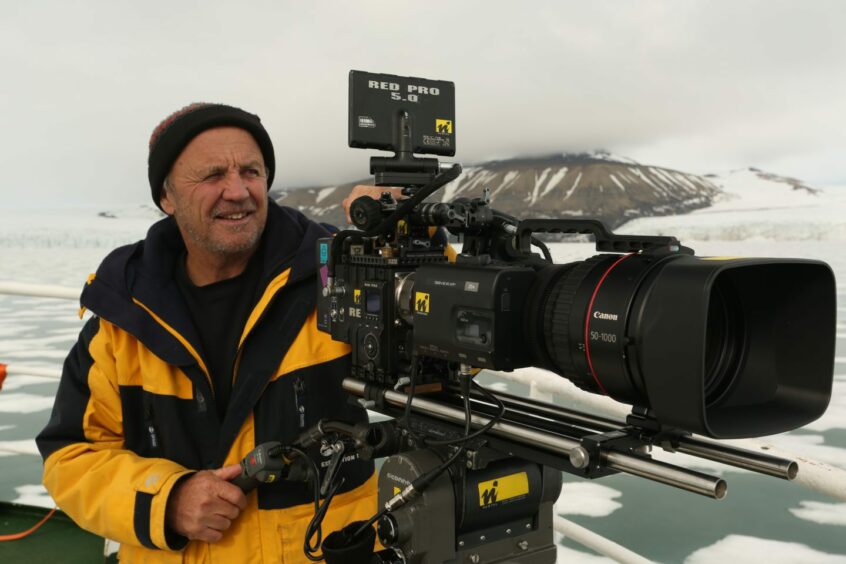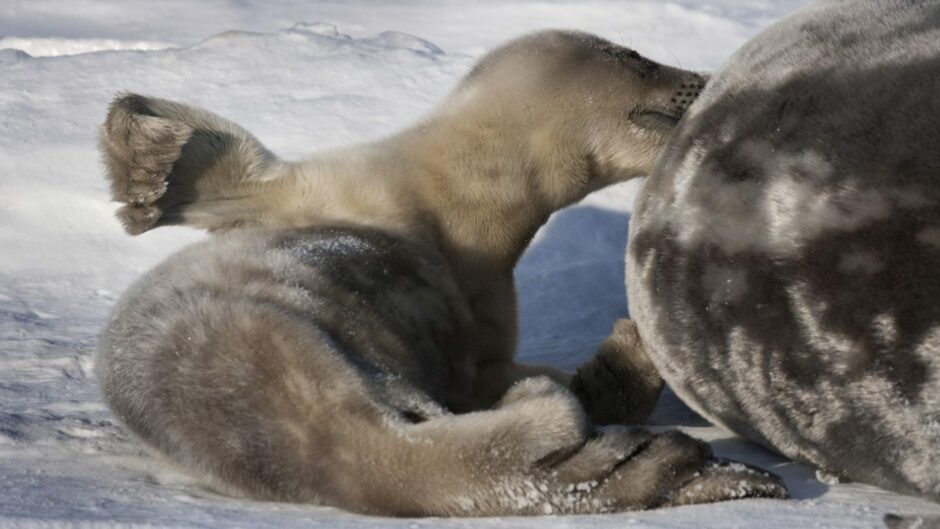Ahead of a talk celebrated wildlife cameraman Doug Allan from Dunfermline is giving to the RSGS in Perth, Michael Alexander speaks to him about 40 years of globe-trotting and hears about his first-hand accounts of climate change.
From scenes shot on the dizzying heights of Mount Everest to close-ups of killer whales hunting in Antarctica, Fife man Doug Allan has provided some of the most memorable wildlife images ever captured.
The Dunfermline born and bred 71-year-old, who first visited Antarctica in 1976, has worked on BBC programmes including Ocean Giants and Planet Earth.
Legendary naturalist Sir David Attenborough has said of him: “Wildlife cameramen don’t come much more special than Doug.”
But as the celebrated wildlife cameraman prepares to give a talk to the Royal Scottish Geographical Society in Perth about over 40 years behind the camera, Doug says wildlife documentary makers have themselves reached a point where reportage of the planet’s changing environment is the subject of climate-change scrutiny.
Tackling climate change
While the BBC now do “carbon calculations” to work out the carbon footprint of their programmes, it’s been realised, thanks to Covid-19 restrictions, that instead of sending British or American film crews to remote locations around the world, there’s often very good camera people available locally.
While wildlife films tend to have higher carbon footprints due to their travel to and lengthy stays in remote locations, it’s also been suggested that the industry could do a better job of “sharing resource”.
For example, if archived or even unused sequences were more readily shared, it could take away the need for other production companies to “re-invent the wheel” while making climate-harming journeys.
But having witnessed major changes to the global environment – and now having to strike a balance between informing the world about the crisis and potentially being accused of being part of the problem through international travel – Doug also thinks there needs to be more emphasise on the climate messaging of wildlife films.
“It’s something that the industry is actively debating at the moment and I think it’s something that’s going to become increasingly relevant,” explains Doug in an interview with The Courier.
“For example Spring Watch this year on the BBC, they need a lot of power for their set-up because basically they become an outside broadcast for the month that they are operating.
“They had hydrogen based generators this year rather than burning fossil fuels in their generators to produce power for their outside broadcast unit.
“While it’s more expensive, it’s a praiseworthy thing for them to do.
“But if you are going to go to the middle of the Arctic, it’s going to be a while before hydrogen generators are going to be taken as easily out there, because they need the extra hydrogen etc as opposed to a can of fuel.
“That said it’s a good example to set and is the sort of example that should be set as often as we can.”
How did Doug get into filming?
Born and bred in Dunfermline, Bristol-based Doug’s interest in adventure can be traced back to his formative years.
From explorers climbing Everest to the space race, and from the work of French film-maker Jacques Cousteau to reading about the 1947 Kon-Tiki expedition which demonstrated that South American peoples could have journeyed to the islands of the South Pacific by balsa raft, Doug recalls how these real-world adventure stories in “simpler times” made him “excited”.
Doug was lucky enough to go with his family on the first wave of relatively cheap package deals to the Mediterranean.
The experience of snorkelling and diving in clear warm water also opened his eyes to the natural world.
It was when he went to study marine biology at Stirling University, however, at a time when environmentalism was becoming all the rage, that he became truly fascinated by the underwater world.
“I remember going to university and for the first time seeing some maps that National Geographic did in the late ‘60s, that imagined that all the sea had been drained away and what you saw was the underwater geography of the sea,” he says.
“These maps – the vertical projections – were hopelessly exaggerated.
“What was in reality a shallow slope you could walk up became like a steep slope you’d almost have to climb up.
“But when you saw that map, I just thought ‘jeez what an exciting place to explore underneath the sea must be’.
“That really fired me to get into marine biology and that was when environmentalism was on the rise and awareness was growing that the planet might be stressed.”
Search for diving jobs
After graduation, Doug was keen to carry on exploring and he looked for diving jobs on expeditions.
His big break came in 1976 when he got to go to the Antarctic.
That’s when photography also really took hold of him.
“Prior to that time I’d dabbled with it, but in the Antarctic was truly where it become an all-fulfilling thing to do,” he says.
“I began to take a photo journalism approach in a way.
“I got very interested in photography and became quite good at it.”
Doug recalls how the “final bit of luck” came in 1981 when David Attenborough visited the base he was on with a small film crew.
“I helped him over those few days, and by the end it, it seemed to me that the cameraman who was working for David was doing all the things that I wanted to do,” says Doug.
“He was a diver, he was travelling, they were working in a small tightly knit group and they were having a good time. My God were they fun to be with!
“And I just thought wouldn’t it be great to be someone like that.
“As I questioned them, they gave me the impression it wasn’t impossible and actually what I knew as a scientist and as a person who worked in the Antarctic was actually pretty useful, because the Antarctic was a very unexplored part of the world photographically.
“So that’s where I shifted direction and made the leap into wildlife filming, and that’s what managed to sustain me since.”
‘Immensely privileged’
Doug says he’s been “immensely privileged”. He’s enjoyed a “massive variety” of work.
In those early days, when the “world was a simpler place”, they could do it with a “clear conscience”, he says in terms of climate impact.
Today, however, it’s got “more complicated” to travel and “more difficult”.
“There are fewer, smaller truly wild places,” he says, “and a lot of pressure on them.
“There’s many more people travelling around simply wanting to see those places as well, and while I wouldn’t want to somehow take away that right from other people to travel and go where they want, it does make filming difficult just because there are so many other people trying to access that place too”.
While debate about the contribution of international travel to climate change continues, what can’t be lost sight of is the changes that Doug has had the privilege – and misfortune – of seeing in the world during his time.
For example, when Doug first wintered on the Antarctic’s Signy Island in 1976, even in the middle of February towards the end of the Antarctic summer, the island still had a permanent ice cap in the centre.
In winter it was possible to ski from the top of the Signy ice cap all the way down to the coast.
By 2011, however, it was only possible to ski half of it because the ice on the lower reaches had completely disappeared.
Since then even more has gone and by 2030, Doug says it’s predicted that the island’s entire ice cap will have vanished.
“I don’t know how many 10s of 1000s of years the ice cap was on Signy,” he says, “but it was a very long time and it’s disappeared in the space of 40 or 50 years. That’s sad!”
Elsewhere, Doug has seen the distribution of penguins change on the peninsula.
“It doesn’t mean the penguins have necessarily disappeared or the numbers have left,” he says.
“But where they are living has changed and some penguins have replaced other ones because the Antarctic peninsula is warming and the snow is melting earlier in the summer.
“This means some Antarctic penguins are able to compete better with the more true Antarctic penguins like the Adelies.
“Climate change is also shifting the prey further away meaning that the aggregations of krill nowadays are just too far away from the colonies so the animals can’t make the transit times.
“But I think anyone who travels over the world will see the differences and see the way things are changing.
“Sometimes animals are able to move and cope with it, and sometimes they can’t.
“Basically what we are seeing now is people can’t move and they can’t cope because people can be restricted by completely artificial national boundaries and the climate of one country which 30 or 40 years could have sustained a certain number of nomad farmers – those people can no longer grow their crops or look after their animals.
“At the same time they just can’t move countries because of the artificial divisions called boundaries we now have between countries.”
‘Reflective’ approach to talk
Doug says he could “talk for hours” about climate change.
Having seen whale hunting massively reduced from peak kill rates in 1968 to save the whale – despite resistance – he believes similar massive steps should be taken to overcome climate change.
When he talks to the RSGS on December 21, however, he’ll be taking a more “reflective” approach to his career.
This will partly be a wistful look back but also how powerful science has become.
He’ll reflect on what a great tool it is, how much humans now know about the environment, and how much humans should be harnessing this knowledge so appropriate action can be taken.
He’ll also be looking back at this “wonderful collaboration” between filming and science and how the two have come together to give these unique experiences that he’s had over the last 45 years.
Doug will be looking back over successes and setbacks from over 40 years of natural history film-making, sharing stories from polar encounters, life in a penguin colony, diving under the ice, and his perspective on a changing planet.
“We get the chance to spend long periods of time in remote locations, waiting for impressive animals to do natural behaviour in front of us,” he says.
“Some of that natural behaviour we may never have seen before.
“So we have a really strong position to bring experiences into peoples’ living rooms.
“That along with always improving technology gives us an eye through our cameras into places where no human eye has been before.
“When you start looking into the darkness with very low light cameras or infrared light and stuff like that, then you see things that no human could possibly ever see!”
RSGS chief executive Mike Robinson adds: “We are so pleased to be hosting Doug Allan in Perth.
“As a veteran speaker for our Inspiring People talks programme, Doug never fails to delight – not just with his remarkable stories, but also through the incredibly personal way he reflects on the natural world around him.
“It is rare that those working behind the camera are as well-known as Doug, which is a true testament to the quality and passion he puts into his photography.”
How to catch the RSGS talk
Doug Allan’s talk Four Decades Behind a Camera will take place at 7.30pm on Wednesday December 21 at Perth Concert Hall, Mill Street, Perth, PH1 5HZ.
Tickets are £20 for general admission, £15 for RSGS members, and £10 for students and u18s, plus a £2.50 booking fee.
To book tickets visit www.horsecross.co.uk or call 01738 621031.























Conversation